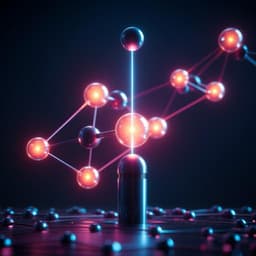
Engineering and Technology
Rapid, continuous projection multi-photon 3D printing enabled by spatiotemporal focusing of femtosecond pulses
P. Somers, Z. Liang, et al.
Discover a breakthrough in 3D micro/nanostructure fabrication with a high-speed projection multi-photon printing method! This innovative approach, utilizing spatiotemporal focusing for precise layer confinement, is demonstrated by authors Paul Somers, Zihao Liang, Jason E. Johnson, Bryan W. Boudouris, Liang Pan, and Xianfan Xu, achieving remarkable fabrication rates that promise scalability and efficiency in micro/nanofabrication.
~3 min • Beginner • English
Introduction
Multi-photon lithography (MPL) enables arbitrary 3D micro/nanoscale structuring with sub-micrometer resolution but conventional point-scanning limits throughput, hindering translation to larger-scale manufacturing. Prior efforts to increase speed include multi-focus approaches, which tend to favor periodic structures, and holographic or direct 2D image projection, which reduce mechanical scanning but face the challenge of confining polymerization axially in multi-photon processes. Temporal focusing using gratings and, more recently, digital micromirror devices (DMDs) with efficient photoinitiators improves axial confinement, but earlier implementations were limited by low laser repetition rates (∼1 kHz) and layer-by-layer approaches with laser off time between layers. In this work, the authors construct a continuous, layer-by-layer projection two-photon lithography system that uses a DMD both for dynamic patterning and to introduce angular dispersion enabling spatiotemporal focusing of femtosecond pulses. They also develop a numerical model capturing the spatiotemporal focusing and imaging behavior, validate it experimentally, and demonstrate complex, smooth 3D structures at millimeter scales with printing rates above 10⁻³ mm³ s⁻¹ using a 5 kHz laser, establishing a high-throughput continuous projection process without laser off time.
Literature Review
The literature on accelerating MPL includes: (1) multiple simultaneous foci via diffractive optics or beam splitting to raise voxel rates (e.g., a 9-spot system reaching ~10⁷ voxels s⁻¹ ≈ >10⁻³ mm³ s⁻¹), though typically suited to periodic structures; (2) holographic approaches and direct 2D image projection to print entire layers or patterns at once, reducing or eliminating mechanical scanning; and (3) temporal focusing to confine intensity to a thin axial plane by dispersing and recombining femtosecond pulse spectra, implemented with gratings or simplified using DMDs plus efficient photoinitiators. Limitations of prior temporal focusing implementations include low laser repetition rates (∼1 kHz) and discrete layer processing with off times, as well as challenges in suppressing out-of-plane exposure in multi-photon projection. These gaps motivate a continuous, higher-repetition-rate, projection-based MPL method with robust axial confinement.
Methodology
System architecture: A spatiotemporally focused projection two-photon lithography setup was built using a DMD (Texas Instruments DLP3000) for dynamic patterning (up to 4 kHz) and to impart angular dispersion for temporal focusing. An 800 nm femtosecond laser (Spectra-Physics Spitfire, 22 nm bandwidth, 5 kHz repetition rate) was used. The input Gaussian beam was converted to a flattop with a beam shaper, expanded by lenses L1 (f=100 mm) and L2 (f=150 mm) to fill the DMD, and the DMD-diffracted light was collected by L3 (f=300 mm). A high-NA microscope objective (100×, Nikon NA 1.49) imaged the DMD pattern onto the print plane within a liquid photoresist on a glass substrate mounted on a 3-axis translation stage. The DMD’s micromirror array acted as a composite grating (from pixel pitch and mirror tilt), providing angular dispersion; spectral components recombined at the image plane to create a short, high-peak-intensity pulse, while away from the plane the pulse temporally stretched, lowering peak intensity and confining polymerization axially (spatiotemporal focusing). Continuous projection printing was achieved by streaming DMD patterns without pauses between layers synchronized with laser pulses at 5 kHz.
Modeling and simulation: A numerical model was developed to compute the spatiotemporal focusing and imaging, incorporating DMD grating orientation (2D grating from mirror grid spacing and 1D grating from mirror tilt), propagation, imaging through the 4f relay and objective, spectral dispersion/recombination, and pulse temporal evolution. Simulations produced spatial (xy) and axial (z) profiles of peak pulse intensity P across and around the print plane. Simulated results showed rapid axial decay of P within about ±0.5 μm to ±1 μm around the print plane for a large-area pattern (1.52 mm × 2.28 mm on the DMD), indicating potential for micrometer-scale layer thickness.
Experimental characterization: To compare with simulation, single-layer rectangular patterns spanning the DMD length (2.28 mm width on the DMD; ~150× demagnification yielding an expected ~15.23 μm image width) were projected and printed while suspended between prefabricated supports. Exposure time per layer and laser intensity at the print plane (144, 156, 168 W cm⁻²) were varied. Layer width and thickness were measured by SEM; thickness was assessed at the center cross-section of suspended layers. Additional tests printed arrays of suspended lines with varying target DMD linewidths to assess achievable feature sizes; resultant linewidths and heights were measured, including angled SEM views. The role of oxygen inhibition and resist shrinkage was evaluated qualitatively through observed width “necking” at low exposure and deviations from target dimensions. Axial layer resolution (minimum interlayer spacing maintaining a gap) was assessed separately and compared to single-layer thickness to evaluate proximity effects.
Key Findings
- Spatiotemporal confinement: Simulations and experiments indicate the peak pulse intensity drops rapidly within ~1 μm around the print plane, enabling thin, planar exposure confined to micrometer and sub-micrometer scales.
- Continuous projection MPL: A DMD-based, spatiotemporally focused projection system operating with a 5 kHz laser enabled continuous, layer-by-layer fabrication without laser off time between layers.
- Throughput and scale: Complex 3D structures with smooth features were fabricated, with millimeter-scale printing demonstrated at rates above 10⁻³ mm³ s⁻¹.
- Single-layer metrics (2.28 mm DMD-width pattern; ~150× demagnification):
• Printed width approached a constant ~12 μm at higher exposures, below the ~15.23 μm expected from imaging, attributed primarily to resist shrinkage and necking at low exposure.
• Near the exposure threshold where the pattern began to deviate from the target, printed layer thickness was just over 2 μm; thickness increased with exposure time and was expected to plateau due to limited off-plane intensity from spatiotemporal focusing.
• Sub-1 μm layer thickness was achieved for non-ideal shapes, indicating sub-micrometer axial feature capability for planar prints.
- Submicron features: Suspended lines exhibited linewidths <200 nm despite larger target DMD linewidths, due to edge inhibition and shrinkage; line heights <1 μm were achieved. Line height increased with pattern width and began to plateau for target widths of ~2–3 μm, consistent with a transition from inhibition-dominated confinement to spatiotemporal focusing-limited thickness.
- Axial resolution: Minimum interlayer spacing to maintain a gap (axial layer resolution) was slightly larger than the single-layer axial feature size, consistent with proximity effects in two-photon polymerization.
- Model validation: Numerical predictions of spatiotemporal focusing and axial confinement were supported by optical imaging and printing outcomes.
Discussion
The study addresses the central challenge of scaling MPL throughput while preserving submicron resolution by combining 2D image projection with spatiotemporal focusing. The DMD simultaneously provides dynamic patterning and angular dispersion, enabling axial confinement of polymerization to a thin plane and therefore making large-area, layer-wise exposure feasible without inducing out-of-plane curing. Operating at 5 kHz and streaming patterns eliminates interlayer dead time, directly improving throughput and enabling continuous fabrication. Experimental measurements align with simulations, confirming effective axial confinement and validating the modeling approach. Observed deviations in lateral dimensions and thickness arise from material effects, notably oxygen inhibition and resist shrinkage, highlighting the interplay between photochemistry and optical confinement: for small features, inhibition dominates and can reduce linewidths substantially below the projected pattern; for larger areas, oxygen depletion reduces the threshold, and spatiotemporal focusing becomes the dominant limiter of thickness, leading to plateau behavior. The demonstrated print rates, sub-200 nm features, and sub-micrometer axial control show that projection-based MPL can achieve both speed and resolution, making it a promising route toward practical, scalable micro/nanofabrication.
Conclusion
This work demonstrates a rapid, continuous projection multi-photon 3D printing method that leverages DMD-enabled spatiotemporal focusing to confine exposure to thin layers while projecting entire 2D patterns. A comprehensive numerical model of the optical system was developed and validated. Experiments achieved millimeter-scale structures at rates >10⁻³ mm³ s⁻¹, with sub-200 nm linewidths and sub-micrometer axial features, and confirmed axial confinement consistent with simulations. The approach is scalable and compatible with complex, smooth 3D geometries, indicating strong potential for practical, high-throughput micro/nanofabrication. Future work could focus on reducing resist shrinkage (e.g., low-shrinkage hybrid resists compatible with efficient photoinitiators and dip-in methods), optimizing photochemistry to manage oxygen inhibition, increasing pattern and laser repetition rates, and refining optical designs to further improve axial confinement and throughput.
Limitations
- Material shrinkage: The PETA-based resist exhibited significant shrinkage and necking, leading to lateral dimension undershoot and influencing measured widths and thickness; low-shrinkage resists (e.g., SZ2080) were noted but were incompatible with the chosen photoinitiator (BBK) and not suitable for dip-in lithography in this setup.
- Proximity effects: Axial layer resolution was slightly larger than single-layer axial feature size due to two-photon proximity effects and oxygen inhibition dynamics.
- Equipment constraints: DMD pattern rate (up to 4 kHz) and laser repetition rate (5 kHz) set current speed limits; optical power and bandwidth also constrain maximum layer thickness before plateauing.
- Generalizability of modeling: While validated qualitatively and quantitatively in key aspects, the numerical model’s accuracy may depend on system-specific parameters (e.g., precise dispersion, alignment, and resist kinetics) not exhaustively characterized here.
- Inhibition dynamics: Oxygen diffusion and depletion affect threshold behavior and thickness growth during continuous exposure, introducing process sensitivity to environmental and material conditions.
Related Publications
Explore these studies to deepen your understanding of the subject.







